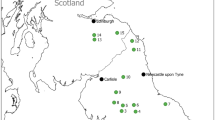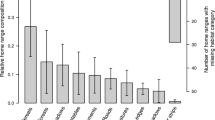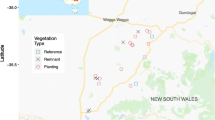Abstract
To aid effective conservation and management there is a need to understand the effect of landscape on species ecology. The aim of this research was to assess the effect of landscape parameters on breeding success of barn owls throughout the Rother and Arun River catchments, Sussex, UK. We used a Geographic Information System to describe the habitat mosaic and landscape structure within an estimated home range area of 3 km2 around 85 artificial nest box sites. Results showed that land cover was less heterogeneous at successful sites, with home ranges dominated by a few habitat types of regular patch shapes. Unsuccessful nesting sites had significantly more improved grassland, suburban land and wetlands than successful sites. Cluster analysis and Principle Components Analysis was used to assess the similarity of the habitat mosaic within these areas and pellet analysis was undertaken to assess barn owl diet and prey availability. Ten prey species were recovered from pellets, field vole (Microtus agrestis), common shrews (Sorex araneus) and house mice (Mus musculus) making up nearly 90% of recoveries. However box sites varied in relative proportions of small mammal, and hence prey availability. Results indicated that land use and landscape structure can affect breeding success in barn owls. Higher levels of poor quality small mammal habitat were associated with unsuccessful sites. However, at a landscape scale, the habitat mosaic across the study area lacked variation, limiting analysis and clear correlations between habitat type and positive breeding success, suggesting that a finer scale was needed in future studies utilising this approach.
Similar content being viewed by others
References
A.M. Andries H. Gulink M. Herremans (1994) ArticleTitleSpatial modelling of the barn owl habitat using landscape characteristics from SPOT data Ecography 17 278–287
C.J. Barr R.G.H. Bunce R.T. Clarke R.M. Fuller M.T. Furse M. Gillespie G.B. Groom C.J. Hallam M. Hornung D.C. Howard M.K.J. Ness (1993) Countryside Survey 1990 Main Report Department of the Environment UK
J. Blamire G. Roberts (2001) Review of the Arun and Rother Barn Owl Project 1995–2001 South Downs Conservation Board and West Sussex County Council UK
D.S. Bunn A.B. Warburton R.D.S. Wilson (1982) The Barn Owl Poyser UK
Environment Agency. http://www.environment–agency.gov.uk.
B.S. Everitt S. Landau M. Leese (2001) Cluster Analysis EditionNumber4 Arnold London, UK
A. Farina (1998) Principles and Methods in Landscape Ecology Chapman and Hall London, UK
L.G. Firbank H.R. Arnold B.C. Eversham J.O. Mountford G.L. Radford M.G. Telfer J.R. Treweek N.R.C. Webb T.C.E. Wells (1993) Managing Set-Aside Land for Wildlife ITE research publication No.7, HMSO UK
R. Forman (1995) Land Mosaics. The Ecology of Landscapes and Regions Cambridge University Press Cambridge, UK
J. Fowler L. Cohen P. Jarvis (1999) Practical Statistics for Field Biology Wiley ChichesterWest Sussex, UK
D.E. Glue (1974) ArticleTitleFood of the Barn Owl Bird Study 21 200–210
B.H. Green (1990) ArticleTitleAgricultural intensification and the loss of habitatspecies and amenity of British grasslands: a review of historical change and assessment of future prospects Grass Forage Sci. 45 365–372
S. Harris T. Wollard (1990) The dispersal of mammals in agricultural habitats in Britain R.G.H. Bunce D.C. Howard (Eds) Species Dispersal in Agricultural Hsssabitats Belhaven Press UK 159–188
InstitutionalAuthorNameITE. (2000) Land Cover 2000 Data Institute of Terrestrial Ecology United Kingdom
J. Jacob (2003) ArticleTitleThe response of small mammal populations to flooding Mamm. Biol. 68 102–111
Jeanneret P., Shupbach B., Lips A., Harding J., Steiger J., Waldburger M., Bigler F. and Fried P.M. 1999. Biodiversity patterns in cultivated landscapes: modelling and mapping with GIS and multivariate statistics. In: Heterogeneity in Landscape Ecology. Proceedings of the 1999 annual International Association for Landscape Ecology (UK) conference. UK.
M. Kent P. Coker (1992) Vegetation Description and Analysis a Practical Approach John Wiley & Sons ChichesterUK
R. Love C. Webbon D.E. Glue S. Harris (2000) ArticleTitleChanges in the food of British barn owls (Tyto alba) between 1974 and 1997 Mamm. Rev. 30 107–129 Occurrence Handle10.1046/j.1365-2907.2000.00060.x
C.D. Marti (1999) ArticleTitleNatal and breeding dispersal in barn owls J. Raptor Res. 33 118–189
J.A. Martinez G. Lopez (1995) ArticleTitleDispersal and causes of mortality in the barn owl (Tyto alba) in Spain J. Ornithol. 140 93–100
W.R. Meek P.J. Burman M. Nowakowski T.H. Sparks N.J. Burman (2003) ArticleTitleBarn owl release in lowland southern England – a 21 year study Biol. Conserv. 109 271–282 Occurrence Handle10.1016/S0006-3207(02)00155-6
N. la Pena A. Butet Y. Delettre G. Paillat P. Morant L. Du ParticleLe F. Burel (2003) ArticleTitleResponse of the small mammal community to changes in western French agricultural landscapes Landscape Ecol. 18 265–278 Occurrence Handle10.1023/A:1024452930326
S.M. Percival (1990) Population trends in British barn and tawny owls in relation to environmental changeBTO Report No.57 BTO UK
Ramsar 2003. Ramsar Profiles UK: The Arun Valley, Ramsar Convention on Wetlands, http://www.ramsar.org/pro-files_uk.htm.
Ramsar Convention on Wetlands 1999. The Arun Valley. http://www.ramsar.org/profiles_uk.htm.
Royal Society for the Protection of Birds. 2003. Barn Owls. http://www.rspb.org.uk/birds/guide/b/barnowl/index.asp.
L. Salvati L. Ranazzi A. Manganaro (2002) ArticleTitleHabitat preferences, breeding success and diet of barn owls in Rome: urban versus rural territories J. Raptor Res. 36 224–228
C.R. Shawyer (1987) The Barn Owl of the British Isles: its PastPresent and Future The Hawk and Owl Trust UK
C.R. Shawyer (1994) The Barn Owl Hamlyn Species Guides Hong Kong, China
C.R. Shawyer V.M. Shawyer (1995) An Investigation of the Barn Owl Population Within the Arun and Western Rother Catchments Hawk and Owl Trust UK
C. Stoate N.D. Boatman C. Borralho R. Carvalho G.R. de Snoo D. Eden (2001) ArticleTitleEcological impacts of arable intensification in Europe J. Environ. Manage. 63 337–365 Occurrence Handle10.1006/jema.2001.0473 Occurrence Handle11826719
Sussex Downs Conservation Board (SDCB) http://www. vic.org.uk.
F.H. Tattersall A.E. Avundo W.J. Manley B.J. Hart D.W. Macdonald (2000) ArticleTitleManaging set-aside for field voles Biol. Conserv. 96 123–128 Occurrence Handle10.1016/S0006-3207(99)00098-1
F.H. Tattersall D.W. Macdonald W.J. Manley S. Gates R. Feber B.J. Hart (1997) ArticleTitleSmall mammals on one-year set-aside Acta Theriologica 42 329–334
I.R. Taylor (1994) Barn Owls. Predator-prey Relationships and Conservation Cambridge University Press Cambridge, UK
T.E. Tew (1994) Farmland Hedgerow: HabitatCorridors or Irrelevant T.A. Watt G.P. Buckley (Eds) Hedgerow Management and Nature Conservation, British Ecological Society Wye College Press UK 80–94
R. Tome J. Valkama (2001) ArticleTitleSeasonal variation in the abundance and habitat use of barn owls (Tyto alba) on lowland farmland Ornis Fennica 78 109–118
M.P. Toms H.Q.P. Crick C.R. Shawyer (2001) ArticleTitleThe status of breeding barn owls (Tyto alba) in the UK 1995–1997 Bird Study 48 23–37
J. Valkama E. Korpimaki P. Tolonen (1995) ArticleTitleHabitat utilisation, diet and reproductive success in the kestrel in a temporally and spatially heterogeneous environment Ornis Fennica 72 49–61
S. Waite (2000) Statistical Ecology: A Practical Guide Prentice Hall Harlow, UK
J.A. Webster (1973) ArticleTitleSeasonal variation in mammal contents of barn owl castings Bird Study 32 122–131
West Sussex County Council. 2003. Phase 1 Habitat Surveys. 1:10,000. West Sussex County Council, Chichester.
P. Widen (1994) ArticleTitleHabitat quality for raptors: a field experiment J. Avian Biol. 25 219–223
D.W. Yalden P.A. Morris (1990) The Analysis of Owl Pellets The Mammal Society UK
Author information
Authors and Affiliations
Corresponding author
Rights and permissions
About this article
Cite this article
Bond, G., Burnside, N.G., Metcalfe, D.J. et al. The Effects of Land-use and Landscape Structure on Barn Owl (Tyto alba) Breeding Success in Southern England, U.K.. Landscape Ecol 20, 555–566 (2005). https://doi.org/10.1007/s10980-004-5037-7
Received:
Accepted:
Issue Date:
DOI: https://doi.org/10.1007/s10980-004-5037-7




